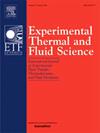由传热系数的相位延迟估计平流速度的物理意义
IF 3.3
2区 工程技术
Q2 ENGINEERING, MECHANICAL
Experimental Thermal and Fluid Science
Pub Date : 2025-08-18
DOI:10.1016/j.expthermflusci.2025.111597
引用次数: 0
摘要
澄清能量装置中传热与流动之间的关系是至关重要的。然而,直接测量传热和流量是具有挑战性的。为了解决这一问题,我们采用了一种基于壁面热数据估算壁面附近流速的方法,并验证了估算速度的物理意义。以雷诺数为2,700、3,300和3,800时的通道湍流为研究对象,利用红外热像仪实验获得的壁面温度数据计算换热系数。根据上下两个位置换热系数时间序列波动的相位差估计流体的平流速度。将估计的平流速度与粒子图像测速(PIV)得到的平流速度进行了比较。时间平均平流速度反映了每一个雷诺数的平均流速的增加。此外,时间平均平流速度与PIV结果在y+= 14.5±1.9处对应,在缓冲层(5 < y+ < 30)内。此外,我们还证实了该方法可以在一定程度上捕获瞬时速度。本文章由计算机程序翻译,如有差异,请以英文原文为准。
Physical meaning of advection velocity estimated from phase delay of heat transfer coefficients
Clarifying the relationship between heat transfer and flow in energy devices is crucial. However, directly measuring heat transfer and flow is challenging. To address this issue, we apply a method for estimating the flow velocity near the wall based on wall thermal data, and we verify the physical meaning of the estimated velocity. Focusing on the channel turbulence at Reynolds numbers of 2,700, 3,300 and 3,800, the heat transfer coefficient was calculated from the wall temperature data experimentally obtained via infrared thermography. The advection velocity of the fluid was estimated based on the phase difference of the time-series fluctuations of the heat transfer coefficients at the upstream and downstream locations. The estimated advection velocity was compared with that obtained via particle image velocimetry (PIV). The time-averaged advection velocity reflects the increase in the mean flow velocity for each Reynolds number. Furthermore, the time-averaged advection velocity corresponded to the PIV results at y+= 14.5 ± 1.9, which was within the buffer layer (5 < y+ < 30). In addition, we confirm that the proposed method can capture instantaneous velocity to some extent.
求助全文
通过发布文献求助,成功后即可免费获取论文全文。
去求助
来源期刊

Experimental Thermal and Fluid Science
工程技术-工程:机械
CiteScore
6.70
自引率
3.10%
发文量
159
审稿时长
34 days
期刊介绍:
Experimental Thermal and Fluid Science provides a forum for research emphasizing experimental work that enhances fundamental understanding of heat transfer, thermodynamics, and fluid mechanics. In addition to the principal areas of research, the journal covers research results in related fields, including combined heat and mass transfer, flows with phase transition, micro- and nano-scale systems, multiphase flow, combustion, radiative transfer, porous media, cryogenics, turbulence, and novel experimental techniques.
 求助内容:
求助内容: 应助结果提醒方式:
应助结果提醒方式:


